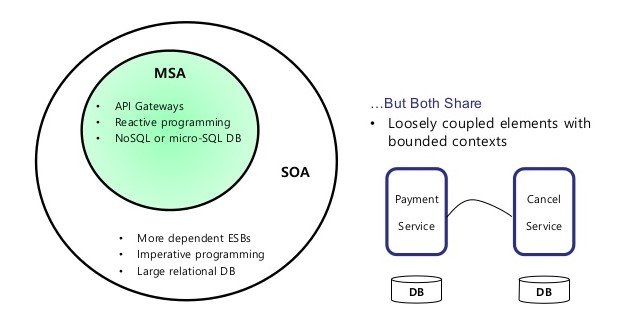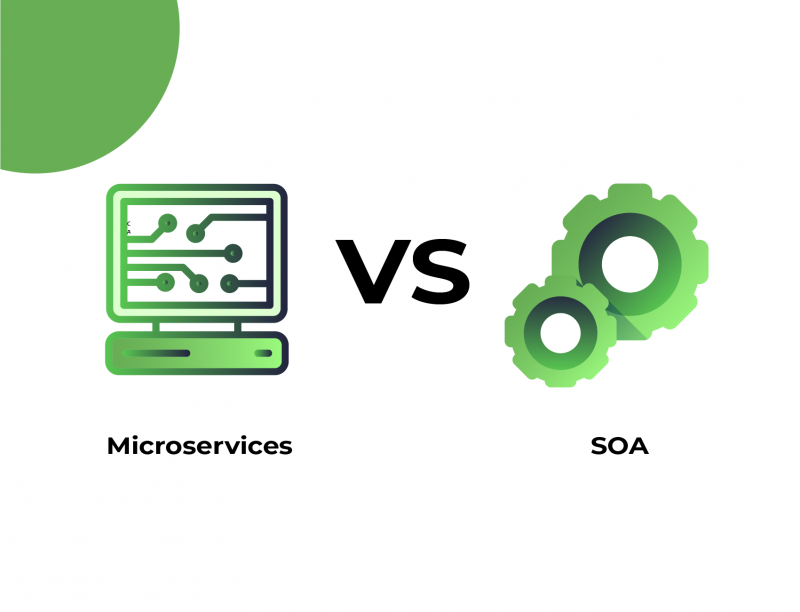Service-oriented architecture and microservices architecture are two reliable architecture approaches that are increasingly used for information system software.
Some experts consider MSA as the natural evolution of SOA. However, if we look at it from a different point of view, microservices should be considered as an independent architecture style that contains its own approach to generate efficient information system software.
The goal of this post is to compare both MSA and SOA and discover which architecture will perform better for your unique information system needs.
Contents
What is Service-Oriented Architecture (SOA)?
As we’ve noticed above, SOA stands for Service-Oriented Architecture. This is the way of software development that supports reusable software components or services. Every service involves the code and data integrations that are needed for executing specific business functions. For example, signing in to a website or checking a client’s credit.
Service interfaces provide loose coupling. They may be called even with no awareness of how the integration is implemented underneath. This loose coupling lets developers save time reusing components in other apps across the entire enterprise.
SOA is known from the late 1990s. It is an essential stage in the app development evolution was actually created as a response to monolithic traditional approaches to building apps.
Before service-oriented architecture, connecting an application to functionality or data in another system required complex integration. Developers had to recreate this integration for every new project.
The key roles of SOA’s are being a service provider and a service consumer. It delivers 4 types of services:
- Functional services for business operations.
- Enterprise services that implement the functionality.
- Application services for developing apps.
- Infrastructure services for non-functional processes, for example, authentication.
What are Microservices (MSA)?
Microservices are loosely coupled independently deployable services. Each service in this microservice architecture collection is aimed to perform a particular task or function and includes all components required for that function. Microservices are typically used to create individual apps in a way that makes them more scalable, resilient, and agile.
Each service is fine-grained and uses language-agnostic APIs. For example, REST for communication with one another. Developers are able to create a service applying the best language for their job, while APIs create a cohesive front-end experience for users, working behind the scenes.
This flexibility helps to solve many essential issues associated with monoliths and SOAs. It is about offering the rapid deployment, scalability, and fault resistance (that service-oriented architecture couldn’t manage to pull off).
Pros and Cons of SOA and MSA architectures
Advantages of SOA architecture
- The application is a monolith that performs s a single service.
- The ability for users to document and analyze information flows because of the USB (Enterprise Service Bus) use.
- It typically works in one physical server that is why the startup time is minimal.
Disadvantages of SOA
- It is hard to scale particular parts of the app.
- Because of the volume of functionalities combined in one monolithic architecture, the app becomes complex.
- The application can halt because of the problems with reliability in one part of the service.
- It looks not easy to apply Agile development strategies.
MSA architecture advantages
- The apps work as modular independent components.
- It is quite easy to develop a single component functionality and test it.
- A single component is also easily maintained.
- The system can be split into pragmatic interconnected components thanks to the low grain and mid-size grain system modularity.
- Microservices can be managed as SCRUM projects.
MSA disadvantages
- The MSA architecture provides complex interconnections between numerous microservices.
- It is not easy to support many databases and transaction management.
- It is also difficult to test and deploy microservices.
- You’ll need an orchestration manager for microservices.
Service-Oriented Architecture vs Microservices: Are There Any Similarities?
Service-oriented architectures are like MSA, meaning that they both represent a collection of services with the focus on performing one specific function. They are smaller in scope than all monolith architecture. Both SOA and MSA require an internal culture with decentralization and cross-functional collaboration.
MSA and SOA provide developers with the freedom to work with any programming language they want to choose. This empowers them to select the language that will appropriate better for that service’s use case.
SOA vs MSA: Key Differences Between Service-Oriented Architecture and Microservices
MSA and SOA are both aimed to resolve various challenges associated with a monolithic architecture. While they have a common goal, service-oriented architecture and microservices have a long list of differences.
Here’s their brief comparison you should be aware of:
Comparing architecture
The architecture of MSA is based on smaller, fine-grained services. They focus on a single purpose and can function independently of one another, interacting and supporting the same app. So, microservices are aimed to share as few service resources as possible.
SOA has larger services that are not independent of one another. It is aimed to share resources as much as possible.
Comparing size and scope
Microservices achieve one function and perform this function in a proper way. They are typically smaller in size and scope in comparison with service-oriented architecture services. It works as a benefit when onboarding new talents.
SOA services may involve numerous functions with many interdependencies, a single database, and ESB. It requires new talents to better understand the service and app interdependencies in full.
Comparing data storage
In the case of MSA, individual services generally have their own data storage, while in the case of SOA solutions, almost all services share the same data storage units.
SOA services reuse shared data due to sharing the same data storage. It is profitable for maximizing data’s value by deploying the same data or apps between business units.
Comparing component sharing
MSA independence decreases the need to share components and makes the services more resistant to failure. Additionally, the lack of component sharing allows developers to deploy newer versions and scale individual services faster.
However, in SOA, component sharing is much more common. Services share access to ESB. Therefore, if you face a problem with one service in relation to the ESB, it can be risky for the effectiveness of the other connected services.
Comparing governance
SOA is based on the idea of sharing resources, so it employs common data governance standards and mechanisms across all services. Microservices have the independence that does not enable uniform data governance mechanisms.
Comparing granularity
Service-oriented architecture services are large, and with the service’s capability to scale, SOA solutions usually have a wider range of focus. Microservices have a more granular nature meaning that individual services look advanced in performing a single specific task.
Comparing communication
Communication in SOA is handled by an ESB. It provides the medium by which services communicate with each other. However, this may significantly slow the communication of SOA services. MSA relies on simpler messaging systems, like APIs that enable faster communication.
Comparing coupling and cohesion
SOA is based on sharing components, while MSA – on the concept of bounded context. This context is the conjunction of a component and its data without extra dependencies. This decreases the need to share components.
Comparing remote services
Both MSA and SOA apply different protocols for accessing remote services. The key remote access protocols for SOA contain SOAP (simple object access protocol), AMQP (advanced messaging queuing protocol, and MSMQ (Microsoft messaging queuing).
For MSA these are REST (representational state transfers) and JMS (Java messaging service).
Comparing deployment issues
Ease of deployment is what really differs MSA and SOA.
In MSA, the services are smaller and largely independent of one another. They are deployed quickly and easily if compare to SOA. Deployment of Service-Oriented Architecture is more complicated by the fact that adding a service involves recreating and redeploying the entire app since services are coupled together.

Microservices vs SOA: What’s the verdict?
Now it is time to define which is better for your business.
MSA solutions have come to a long journey in avoiding the issues that plagued service-oriented architecture in the early days. However, they have the benefits of technology that bound ahead of what was cutting edge in the 90s. It allows developers to look back and learn from mistakes made by those who came before them.
Deciding what to choose, you should not hurry and it worth considering several points. SOA is a modular means and microservices provide a smaller, more fine-grained approach to accomplishing the same objective. The best choice will depend on your business’s own unique needs and use case.





